11 Nutrition: Herbivores
Learning Objectives
- Explain the difference between ruminants and hindgut fermenters
- Describe the production cycle of dairy cows, sheep, and dairy goats
- Describe the normal feeding behaviors of cattle, small ruminants, and horses
- Describe the anatomy and functions of the four chambers of the ruminant stomach
- Explain the production of volatile fatty acids (VFAs) in the rumen and the fate of the various types of VFAs produced
- Describe body condition scoring in cattle, small ruminants, and horses and how body condition score is expected to change with physiologic state
- Explain changes in amount or ration fed in dairy cows and in small ruminants through their production cycle
- Define a total mixed ration and list advantages
- Describe differences in bovine colostrum, transition milk, and whole milk
- Define failure of passive transfer (FPT) and how it is assessed in calves
- Describe assessment of colostrum quality
- Explain how much colostrum is fed to the average calf and how that volume is calculated
- Describe timing of colostrum feeding in ruminants
- Describe types and advantages / disadvantages of feeding raw colostrum, stored colostrum, colostrum replacement products, and heat-treated colostrum
- Describe changes in feeding for calves progressing through the three phases of calf development (pre-ruminant to transition to ruminant)
- Describe how feeding may vary in small ruminants based on time of the year
- Describe creep feeding
- Describe use of coccidiostats when feeding small ruminants
- Describe feeding systems for cattle and small ruminants
- Describe anatomy of the equine GI tract
- Explain ideal percentages of forage and other types of feed for horses
- Describe disease conditions associated with improper nutrition / feeding of herbivores
Cattle, sheep, and goats are ruminants. Young that are still nursing do not function as ruminants as their rumen is still developing. Once weaned, all ruminants ferment food in the rumen and have unique nutritional needs.
Horses are not ruminants but still ferment food. They are hindgut fermenters, who ferment food in the cecum.
*
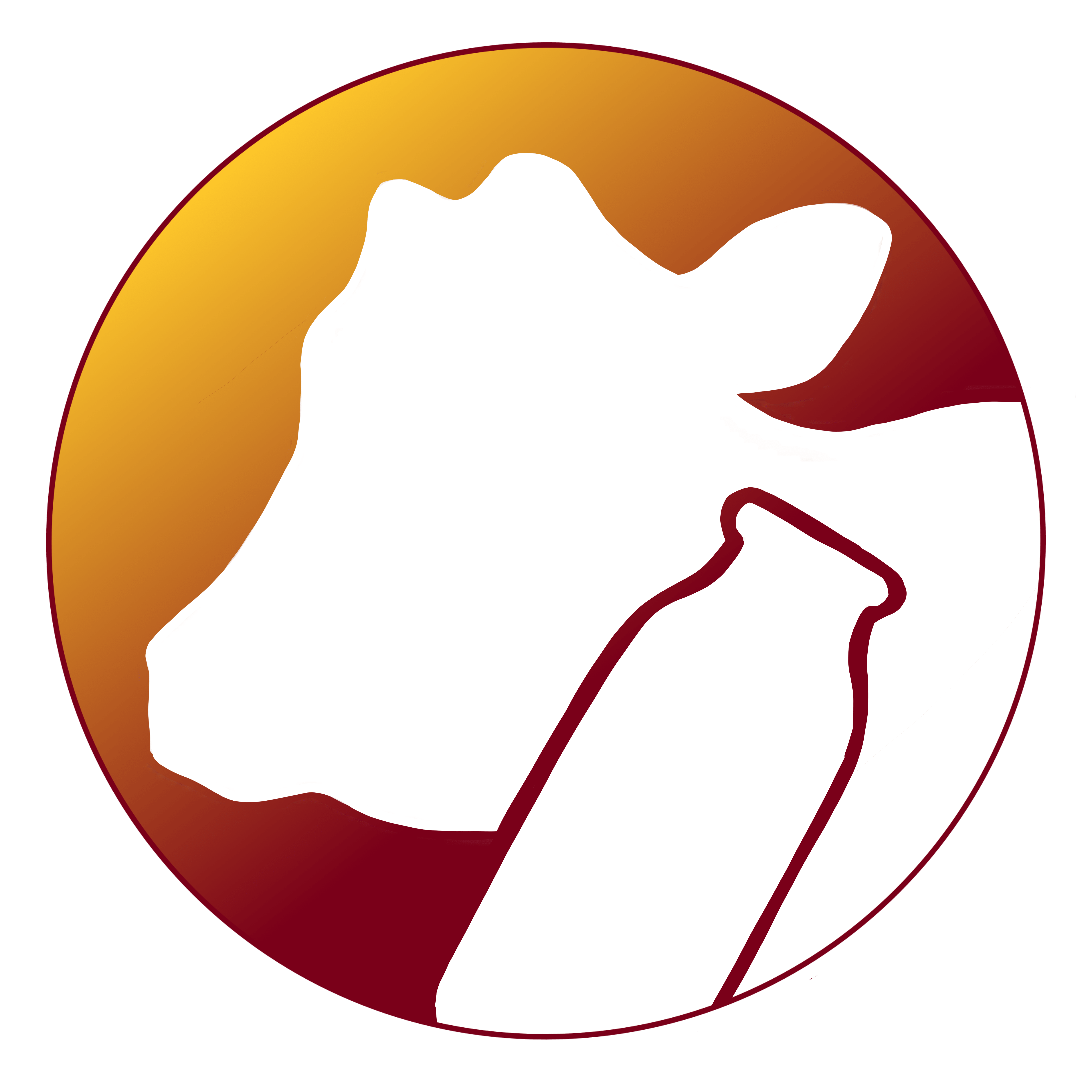 Feeding Dairy Cows
Feeding Dairy Cows
Cows, like all mammals, must give birth to make milk. They typically calve for the first time when 2 years old and have another calf every 13-14 months. Gestation length averages 280 days. They are not milked (dry) for 2 months at the end of pregnancy before the next calf is born. On average, cows have three calves before being replaced in the herd by their daughter (or the next cow’s daughter). Cows are milked 2 or 3 times per day using milking machines that are cleaned and sanitized after each milking shift.
Average duration of lactation (milk production) is 305 days. The cow calves and starts to lactate and there is a voluntary waiting period (usually about 50-60 days) before she’s bred and an average interval from calving to conception of about 85-115 days (because not all cows conceive on their first breeding). She’s then pregnant for about 7 months before she’s dried off (two months before she calves again). That makes lactation about 305 days on average.
Cows are grazers. They are physiologically designed to consume large meals in a short amount of time. Meals are not chewed when consumed. Un-chewed feed is later regurgitated and chewed (the cud) so that particle size is reduced for further passage down the digestive tract.
The cow has four stomach chambers. The reticulum is a specialized pouch of the rumen located adjacent to the heart but separated from it by the diaphragm. It has a honeycomb appearance. It empties primarily into the rumen (large pieces of ingesta) but also empties in the omasum (small pieces of ingesta). It also collects abnormal objects eaten by the cow and so is sometimes called “the hardware stomach.” The rumen lies on the left side of the abdomen. It is lined with papillae to create a huge absorptive surface. It contains muscular pillars. Basically, it is a huge fermentation vat filled primarily with anaerobic bacteria. It is not functional at birth. It serves to store feed for regurgitation, to soak feed, to physically mix and break down feed, and to ferment fibrous feeds, sugars, and starches into volatile fatty acids (VFAs), which are absorbed by the papillae. It also is a source of protein production (some of the rumen micro-organisms synthesize proteins and vitamins), and generates heat (great in the winter, a source of heat stress in the summer). The omasum absorbs water and breaks down the ingesta into small particles by passage through many closely connected layers (“plies”). None of the first three compartments secrete digestive enzymes. The abomasum is a “true stomach” that secretes enzymes; it is a glandular stomach as is seen in monogastric animals like the dog and cat. It secretes hydrochloric acid, mucin, pepsinogen, rennin (which clots casein, or milk proteins), and lipase (which breaks down fats).
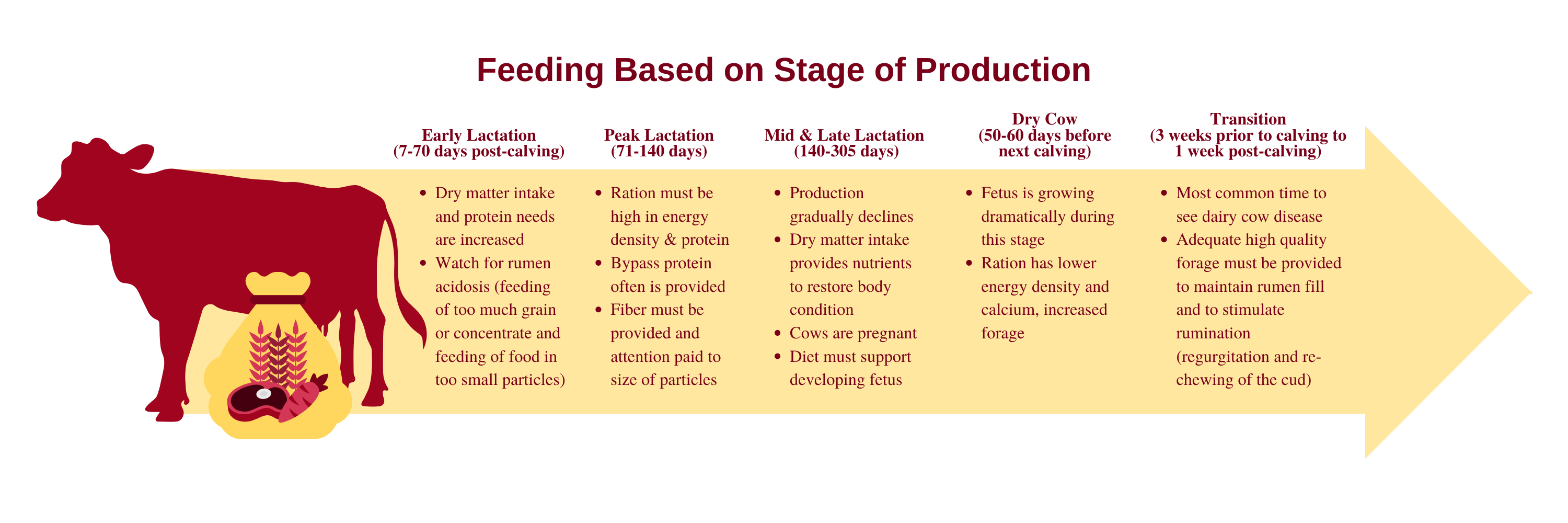
Cows have a more complex digestive system than monogastrics. The food cows eat first passes into the rumen, then is regurgitated and re-chewed, and then passes again into the rumen and on through the three other chambers. In the rumen, bacteria and protozoa break down the food into nutrients the cow can absorb. This allows cows to digest food that humans (or chickens or pigs) cannot digest. Most feed, about 70%, is digested in the rumen by bacteria, protozoa and fungi. Micro-organisms are substrate-specific, breaking down either fiber or starch, for example. Micro-organisms produce VFAs from digested feed; this is the cow’s primary energy source. Micro-organisms also provide a significant source of protein to the cow (microbial protein).
There is no oxygen in the rumen so when carbohydrates are broken down CO2 and H2O cannot be produced. The excess hydrogen is attached to carbon to make methane (CH4), which is eructated (burped) or passed into manure. Fiber is broken down by rumen bacteria to create 2-carbon VFAs (acetate) and 4-carbon VFAs (butyrate) that are absorbed through the rumen wall. VFAs then go to the liver to be made into longer VFAs that contribute to milk fat. Starches and sugars are broken down to form 3-carbon VFAs (propionate) that are converted by the liver to glucose. Glucose plus galactose makes lactose – this is milk sugar and its production drives overall milk production.
Ruminant Digestion
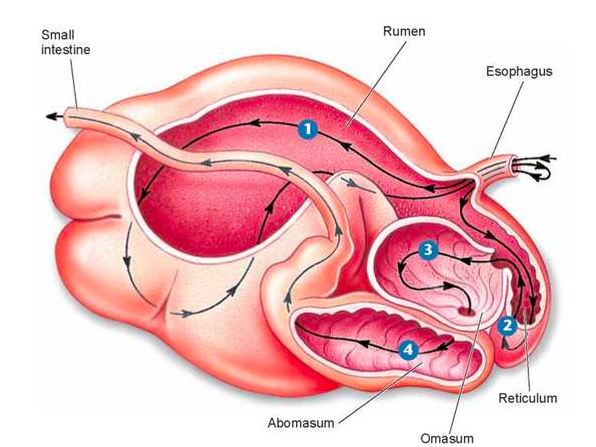
1 = rumen, 2 = reticulum, 3 = omasum, 4 = abomasum |
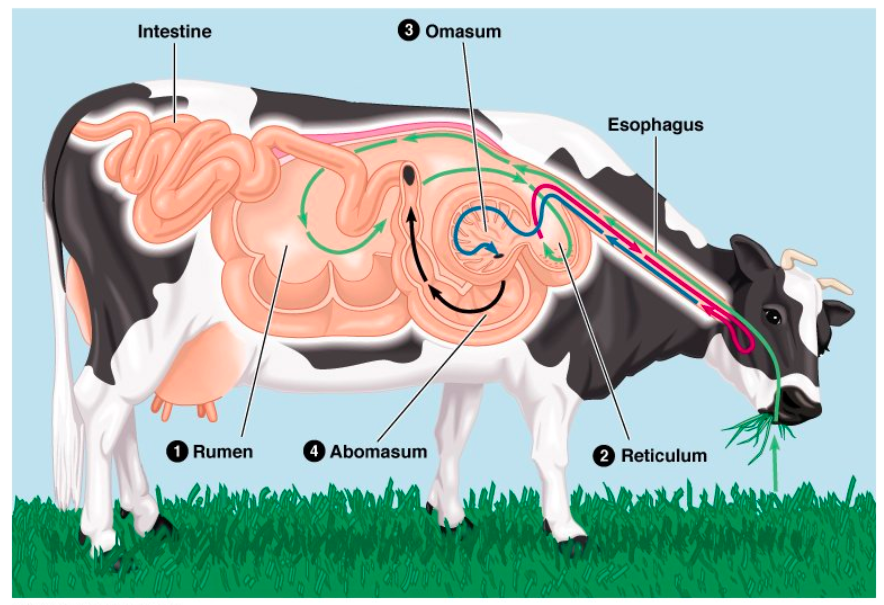 |

The goals of feeding a milking cow are to maintain good cow health and reproduction, to support high milk production, to support good levels of milk components (3.7% fat, 3.2% protein in Holsteins) and to maintain adequate body condition. Cows are scored on a 1-5 scale with 1 being very thin and 5 being obese. Goals are a body condition score (BCS) of greater than 3 at calving, greater than 2.5 at peak lactation, and greater than 3.25 at dry off. After calving, it is 3-6 weeks until peak lactation. Prior to and at the peak, it is hard for a cow physically to eat enough to keep up with metabolic needs of milk production. She will meet energy needs by mobilizing fat and, to a smaller extent, protein. More protein is provided to cows in early lactation. After peak lactation, energy needs will gradually decrease until she is dried off two months before her next calf is due.
Overall Nutrient Needs
- Energy – Carbohydrates and VFAs from rumen and fats
- Protein – Supplied by diet and microbial protein. Cows also get bypass protein, which passes the rumen and is taken up in the small intestine intact. This is needed to support milk production.
- Fiber – Physically necessary in rumen and needed to support acetate production and subsequent creation of butterfat in the milk
- Fats
- Minerals
- Vitamins
Adult cows are fed differently depending on their stage of production. These may or may not be different diets and instead may be different amounts of the same diet. Stages are early lactation (7-70 days post-calving), peak lactation (71-140 days), mid and late lactation (140-305 days), dry cow (50-60 days before next calving), and transition from dry to lactation (3 weeks prior to calving and one week post-calving).
In early lactation there is a rapid increase in milk production. Cows cannot eat enough to take in sufficient energy to balance milk production. Dry matter intake is increased but is limiting as cows can only eat so much dry matter in a day. Protein needs are increased. A big concern in early lactation is rumen acidosis, a common condition where there is overproduction of lactic acid in the rumen with a decrease in production of the more valuable VFAs previously described. Causes of rumen acidosis include feeding of too much grain or concentrate and feeding of food in too small particles. Rumen acidosis is associated with lameness, low butterfat, weight loss, low production, poor reproduction, and eventual culling from the herd.

At peak milk production, intake again is limited by how much dry matter the cow can consume. The ration must be high in energy density, and high in protein; bypass protein often is provided. The cow may lose body condition due to inequality in energy out (milk production) versus energy in. Fiber must be provided and attention paid to size of particles introduced into the rumen to ensure normal rumen health.
At mid to late lactation, production gradually declines. Dry matter intake is associated with taking in enough nutrients to permit body condition to be restored. Cows are pregnant during this phase so the diet provided must support the developing fetus.
Cows are dried off (no longer milked) for about the last two months of gestation. The fetus is growing dramatically during this stage. Cows receive a very different ration during this stage than they had as milking cows, with an increase in forage to prepare the rumen for the next lactation and feeding of a ration with lower energy density. The ration generally is low in calcium and is acidifying; this keeps calcium metabolism pathways operational to reduce chances of post-partum hypocalcemia.
The transition period is the time spanning from 2-3 weeks before calving to about 1 week after calving. This is a stressful time in the cycle as there is a big metabolic shift. This is the most common time to see dairy cow disease – for example, one study demonstrated that cows that ate less dry matter prior to calving were more likely to suffer from uterine infection (metritis) after calving. During this stage, adequate high quality forage must be provided to maintain rumen fill and to stimulate rumination (regurgitation and re-chewing of the cud). The diet is gradually shifted to that of the milking cow to give the rumen microflora time to adapt.
Common feeds are as those described in the Nutrition-Basics section of the course. Other miscellaneous feeds that may be added include bypass protein (fish meal, blood meal, dried brewer’s grains, soybean meal) and bypass fat (Megalac™).
A total mixed ration (TMR) is composed of (1) a base vitamin and mineral mix, (2) an on-farm dry ingredient premix made up of protein mix (protein and concentrate: grain mix), and corn and other grains and byproducts or commodities as described in the Nutrition-Basics section of the course, and (3) forages. Advantages of a TMR is that each mouthful is the same so there is better assurance of a balanced diet delivered to the rumen micro-organisms; there is less chance of a given cow selectively eating or avoiding a single type of feed; each individual cow can consume to her physical ability; and there is savings in labor and mechanization, especially in large operations.
Delivery of the diet includes such factors as order of mixing of components, processing (grinding, heating, extrusion, drying, etc.), and how the feed is provided to the cattle (amount, timing, delivery system, and removal of feed that is not consumed).
Cows may be fed in stanchion barns with feed provided as separate components or as a TMR; fed in freestall barns with bunk feeding, primarily of a TMR; or fed in a variety of other ways including forage in bunks, racks or pasture; feeding of concentrate in the milking parlor; feeding of concentrates in “computer feeders” ,and feeding mineral free choice as loose minerals or salt blocks.

*
Feeding Dairy Calves
Care of the newborn calf includes:
- Monitoring the calving process and assisting if needed
- Removing the calf from the dam ASAP and drying it – The goal is to remove the calf from the dam within 30-60 minutes of birth to decrease exposure to pathogens.
- Disinfecting the navel (for example, 7% iodine dip) to prevent umbilical infection
- Feeding colostrum with the first feeding within 1-2 hours of birth
- Placing in calf housing and feeding a milk diet until weaned at approximately 8 weeks of age
The Five Cs of Successful Calf Rearing
Colostrum – Calories (nutrition) – Comfort – Cleanliness – Consistency
Colostrum
Colostrum is the first milk produced after calving. It contains elevated concentrations of immunoglobulins (primarily IgG and some IgM and IgA), and of proteins and fats – see table below for a comparison between colostrum (first milking after calving), transition milk (second and third milkings after calving), and whole milk (subsequent milk produced).
Comparison of Milks After Calving
| COLOSTRUM | TRANSITION MILK | WHOLE MILK | |
| Total Solids(%) | 23.9 | 14.1 | 12.9 |
| Protein (%) | 14.0 | 5.1 | 3.1 |
| Fat (%) | 6.7 | 3.9 | 3.7 |
| Total Minerals (%) | 1.11 | 0.87 | 0.74 |
| IgG (mg/mL) | 48.0 | 15.0 | 0.6 |
Colostrum is important because cows have an epitheliochorial (6-layer) or a synepitheliochorial (5-layer) placenta. Immunoglobulins cannot cross this placenta to the fetus so calves are born without circulating protective antibodies. Passive transfer is absorption of antibodies by the newborn calf across the gut into the circulation (IgG, IgA, and IgM). Colostral immunoglobulins protect the calf against diseases for the first few months, until the calf can produce its own immune response. Failure of passive transfer (FPT) is defined as concentration of IgG in calf serum of less than 10 mg/mL when measured in blood drawn between 24 and 72 hours of age. In one study, 21% of United States dairy heifer calves had FPT. Benefits of having adequate passive transfer include reduced treatment and mortality rates in calves, improved growth rates and feed efficiency, decreased age at first calving, and increased first and second lactation milk production. Some of these parameters are not measured until cows are over 3 years of age so you can see that calf management has long-reaching effects.
The 5 Qs of a Successful Colostrum Management Program
Quality – Quantity – Quickness – sQueaky clean – Quantifying results

Quality
Quality of colostrum is defined by amount of IgG within that colostrum. Feeding of colostrum that contains at least 50 mg/mL of IgG is associated with achieving > 10 mg/mL IgG in the calf’s serum, or successful passive transfer.
Factors that Affect Colostrum Quality
| FACTORS NOT UNDER MANAGEMENT’S CONTROL | FACTORS UNDER MANAGEMENT’S CONTROL |
| Breed – Colostrum quality is higher in colored breeds than in Holsteins | Dry cow nutrition |
| Parity – Colostrum quality is higher in older cows than in first calf heifers | Stress during dry period (heat stress, overcrowding) |
| Pre-partum leaking | Vaccination during dry period – may be stressful but also important for increasing antibodies |
| Clinical mastitis (infection of the mammary glands – this milk must be discarded) | |
| Time to first milking – Optimally harvest colostrum within 1-2 hours of calving; beyond 6 hours, quality significantly declines | |
| Dry period length – Colostrum quality suffers if the dry period is less than 3 weeks in length |
Colostrum quality is measured using a colostrometer or Brix refractometer. A colostrometer measures specific gravity. Its sensitivity is 75% and specificity is 87%. It is inexpensive, rapid, and simple to do but the instrument is fragile and the test must be performed at room temperature. The Brix refractometer measures total solids. Its sensitivity is 90.5% and specificity is 85%. It is more expensive but is rapid and simple and the test is not temperature-dependent.
Quantity
Often we do not have a clear idea of how much IgG is in the colostrum. Most people hedge their bets by giving a large enough volume to ensure that calves are receiving enough IgG. To achieve IgG of greater than 10 mg/mL in serum, calves must consume more than 100 gm of IgG in colostrum. If calves are fed 4 quarts of colostrum, this goal will be met 87% of the time. The current recommendation is to feed 10% of body weight at first feeding – for the average Holstein calf, which weighs 43 kg (90 lbs), that would be 3.8 liters (4 quarts).
Quickness
Quickness refers to time to first feeding. Calves are born with an open gut that is able to absorb large protein molecules intact, such as IgG. Gut closure begins soon after birth with progressive loss of ability to absorb IgG. Closure is complete by 24 hours of life. The goal is to feed colostrum within 1-2 hours of birth and certainly before 6 hours of life. Colostrum can be fed using either a nippled bottle or an esophageal tube. Veterinarians can teach producers how to safely tube feed calves by teaching them proper technique and stressing sanitation and management of the equipment. Options for providing colostrum include:
- Milking the cow and feeding the calf within 1-2 hours – preferred
- Feeding the calf colostrum that was previously collected from a different cow and stored (refrigerated or frozen)
- Feeding a commercial colostrum replacer product
- The calf suckling the dam – This is NOT preferred as it is associated with high FPT rates and increases exposure of the calf to pathogens.
sQueaky Clean
This refers to bacterial contamination. Colostrum is frequently an early source of microbial exposure. The goal is for colostrum to have a total plate count of fewer than 100,000 CFU/ml with total coliform count less than 10,000 CFU/ml. In one study, 82% of Wisconsin herds and 93% of Minnesota herds exceeded these amounts. If there are many bacteria in colostrum, this may prevent IgG absorption from the calf’s GI tract and may directly cause disease. The three major sources of colostrum contamination are:
- Infection from the mammary gland or fecal contamination of skin on the teats
- This is best avoided by discarding milk from known diseased cows, not letting the calf suckle the dam, cleaning and sanitizing the udder before milk collection, and not pooling raw colostrum to be sure that colostrum containing bacteria from one cow does not adulterate good colostrum from other cows.
- Contaminated collection or storage equipment
- This is best avoided by scrupulously cleaning equipment.
- Bacterial proliferation in stored colostrum
- This is avoided by feeding colostrum within 1-2 hours of collection, refrigerating it (use within 48 hours), or freezing it as soon as possible after collection.
Other techniques include feeding colostrum replacement products and heat-treating colostrum. Colostrum replacement products are powdered colostrum that is mixed with water. There is a minimum of 100 gm IgG per dose and cost is $25-30 / dose. It is a convenient, consistent source of IgG and controls disease transmission. One dose is equivalent to about 2 quarts of colostrum so most calves should receive at least two doses to try to avoid FPT. There is variation between products. Heat-treating is a relatively new technique. In one study, calves fed heat-treated colostrum were treated less and had less diarrhea (scours) than calves fed fresh colostrum.
Quantifying the Results
IgG in serum is not often measured. Total protein is more commonly measured; serum total protein of 5.0-5.2 gm/dL most accurately predicts serum IgG of 10 mg/mL. On-farm monitoring of passive transfer requires bleeding of about 12 clinically normal calves between 1 and 7 days old and measuring total protein with a refractometer. Goals are for 90% or more of the calves to have a total protein greater than 5.2 gm/dL. Higher is better!
Calories
Goals are for calves to double birth weight by 56 days of age (average daily gain (ADG) of 1.6-1.8 lb/day) and for calves to develop a functional rumen so the calf can be weaned off a milk diet and onto solid feed by 7-8 weeks of age.
Rumen Capacity as % of Total
The abomasum does not change in size as cows grow but the rumen changes dramatically in size and function.
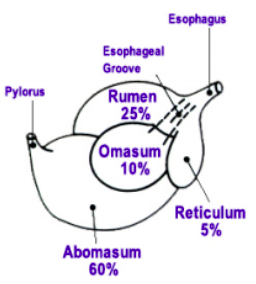
| AGE | ABOMASUM CAPACITY | RUMEN CAPACITY |
| 1 week | 60% | 25% |
| 3-4 months | 20% | 65% |
| Maturity | 7-8% | 80% |
Phases of Calf Development
There are three phases of calf development: Pre-ruminant phase (birth to 3-4 weeks) – Transition phase (3-4 weeks to weaning) – Ruminant phase (weaning to 225 lbs and beyond)
Pre-Ruminant Phase (birth to 3-4 weeks of age)
Baby calves do not have a functional rumen. They cannot digest solid feed and have limited rumen fermentation capacity. The rumen has no absorptive papillae and the rumen wall is thin. The abomasum is the main compartment involved in digestion. Calves are dependent on a liquid diet (milk) as their major source of nutrients. Their diet consists of high-quality milk replacer, calf starter (pelleted grain), and water. Calves are fed whole milk or milk replacer in a volume of 2-3 quarts twice daily in summer and 3-4 quarts twice daily in winter, when more energy is needed for cold stress; some producers feed three times on cold winter days. Offer free choice starter grain after 3 days of age and offer free choice water after 3 days of age. Some producers like to offer a small amount of dry hay but this does not contribute to rumen development prior to weaning. Milk generally bypasses the rumen via the esophageal groove and empties directly into the abomasum; reported stimuli for contracture of the esophageal groove include presence of milk solutes (proteins and other solids), the suckling of the calf, and the warm temperature of the fluid ingested. Esterase in the saliva begins fat digestion. Within the abomasum, milk clots within 10 minutes. Chymosin (rennin) acts on casein. The whey (liquid) fraction still includes many proteins, including antibodies. The milk clot is slowly digested by pepsin and HCl and is released to the intestines. Milk proteins but not vegetable proteins are best digested – look for this in milk replacers, as high-quality milk replacers will contain milk proteins, not soy or other vegetable-based proteins. In the small intestines, lactose is digested but starches and non-lactose disaccharides such as sucrose are essentially not digested during this phase. Pancreatic protein enzymes (trypsin and chymotrypsin) increase gradually.
Options for liquid feed for calves include milk replacer (generally 20% crude protein and 20% fat), whole milk, and pasteurized nonsaleable milk (for example, waste or discard milk). Considerations include desired nutrient intake to meet health and growth targets, disease control, complexity of managing the feeding program, and cost-benefit analysis.
Milk Replacer Programs
Nutrient Levels (e.g. 20 : 20 = Crude protein % : Fat)
- Crude protein: 18-30%
- Fat: 15-20% (up to 25% for Jerseys)
Protein Sources
- All milk – Whey protein: best mixing, highly digestible, most expensive
- Alternative proteins:
- Soy protein concentrate
- Soluble wheat gluten
- Plasma
- Soy protein or modified soy flour isolate
- Egg protein
Fat Sources
- Lard – Probably the best and most economical
- Tallow – Can be less expensive at some times of the year
- Vegetable – Most expensive option today
Use of pasteurized non-saleable milk may be cost-effective. Pros include reduced pathogen transmission compared to raw milk, improved rate of gain compared to traditional milk replacer, improved calf health, improved economic efficiency, and use of a non-saleable product. Cons include cost of pasteurization and need for more intensive management and monitoring compared to conventional milk replacer programs.
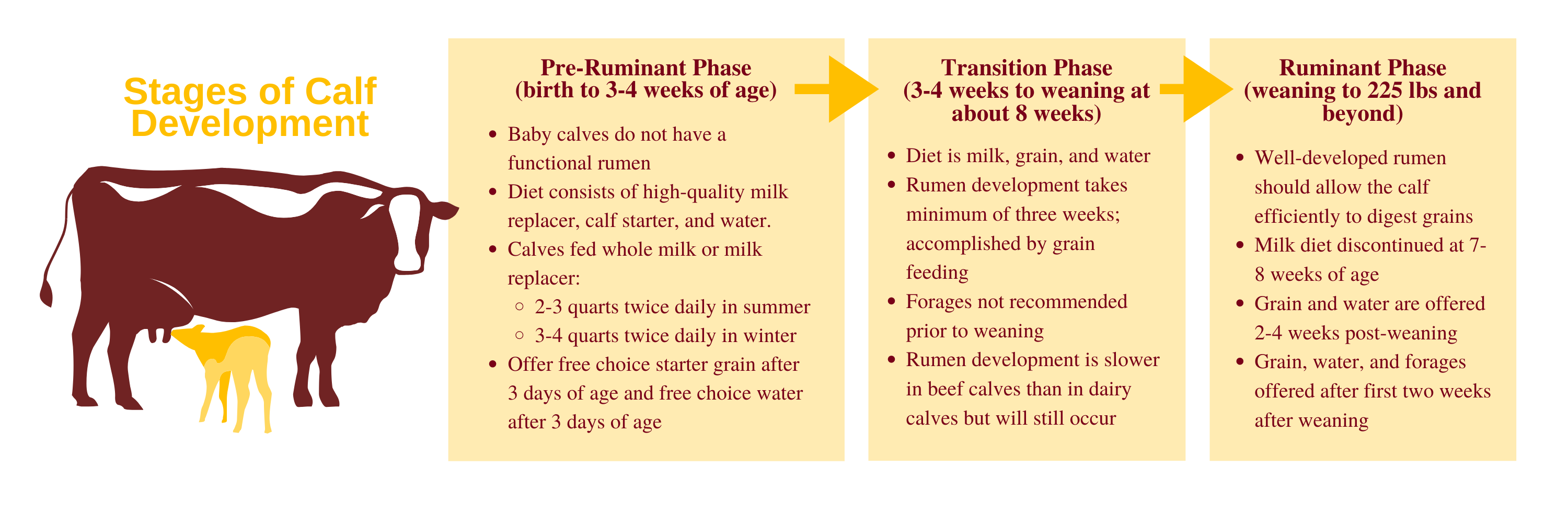
Transition Phase (3-4 weeks to weaning at about 8 weeks)
The diet is milk, grain, and water. During this phase, the calf begins to develop a functional rumen capable of digesting dry feed. Rumen development takes a minimum of three weeks. Rumen development is accomplished by grain feeding to promote butyric and propionic acid production, lowering pH and increasing growth of micro-organisms. This increases the size and muscularity of the rumen, and promotes development of papillae while the microflora is established. The rumen will not develop on a milk-only diet or on milk and forage. Grain feeding is required for development of the rumen in size and function. Forages are not recommended prior to weaning because microbes are not initially capable of fermenting forages, forage fermentation that may occur is associated with acetate production that does not stimulate rumen development, and forages fill the rumen and displace starter grains that would promote rumen development. Note that this is for dairy calves; beef calf management is described below.
Weaning Guidelines for Calves
Reduce stress by spreading out changes:
- Feed changes (weaning)
- Procedures: dehorning, vaccinations, tail docking
- Socialization/grouping, transport, environmental changes
Before weaning, calves should be:
- Eating starter for at least 3 weeks
- Consuming at least 2 lbs of starter per day for 3 consecutive days
- Receiving reduced milk diet by 50% in last 1-2 weeks to increase starter intake
Move to groups after weaning:
- Keep in individual pen on same grain > 7 days after weaning
- Move to small groups initially (6-8 calves)
- Continue on same grain for 1-2 weeks after grouping
- Introduce forages after 3-4 weeks post-weaning
Ruminant Phase (weaning to 225 lbs and beyond)
After 3-4 weeks in the transition phase, a well-developed rumen should allow the calf efficiently to digest grains. A milk (liquid) diet is discontinued at 7-8 weeks of age. For 1-2 weeks post-weaning, grain and water are offered. After that, grain, water, and forages (for example, hay) are offered.

General Considerations When Feeding Calves
Energy Status in Cold Weather
Strategies to improve energy status in cold weather include:
- Increase caloric intake:
-
- Increase volume fed per feeding
- Increase number of feedings per day
- Add supplemental fat
- Select liquid diet with increased energy density
- Decrease energy losses:
-
- Keep calves dry
- Prevent drafts
- Use insulation: extra bedding (straw), calf jackets
- Use supplementary heat if needed
- Increase starter and water intake to promote rumen development
- Avoid illness by health management
Starter Management
You want to encourage starter intake to promote rumen development. This is needed before weaning to onto a cheaper diet of dry feed (no milk).
Calves prefer:
- Textured starters (pellets with corn/oats and molasses)
- Avoiding fines, dust
- Fresh (no mold), palatable, free choice
For best results:
- 21-23% crude protein (dry matter basis)
- Molasses content 5-8%
- Begin offering at 3 days and replace daily
- Provide free-choice fresh water
- Put in clean buckets
- Put in mouth after milk feeding
Free-Choice Water
Free-choice water promotes rumen development by providing an aqueous environment for microbes because milk bypasses the rumen by running through the esophageal groove but water deposits directly in the rumen. Water also promotes greater intake of dry feed. Water is essential to maintain hydration status, especially during periods of heat stress and illness (diarrhea = scours). Provide free-choice fresh water beginning at 3 days old and replace twice daily. Clean and disinfect buckets regularly. In winter, offer warm water for 1 hour after each milk feeding, then dump it before it freezes. In summer, check water at mid-day. Some calves are in an accelerated milk replacer program with high total solids – these calves absolutely must have free-choice water.
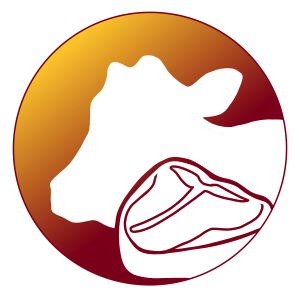 Feeding Beef Cattle and Beef Calves
Feeding Beef Cattle and Beef Calves
What is fed to beef cattle varies widely. Beef cattle readily can use various rough feeds as are found on pasture and, in the United States, may be fed grain as well. As in other species and in dairy cattle, appropriate nutrition for beef cattle varies with life stage.
Breeding Cattle
Cows are bred to produce one calf per year. For the cows and bulls, grazed forage provides the bulk of the nutrition through the growing season. For the upper Midwest, this would typically be pasture from May through October, followed by grazing crop residue, primarily cornstalks, in November and December.
In addition to the grazed feed, beef cattle require supplemental vitamins and minerals for optimal health. These are delivered in the form of a loose mineral or a solid form. Solid products include a lick block, made from salt and minerals compressed into block form, or a lick tub, where vitamins and minerals are mixed with a protein source and molasses and cooked into a solid product that is delivered in a plastic or metal tub weighing 200 to 250 pounds. Supplemental vitamins and minerals are critical in grazing cattle to decrease the incidence of diseases such as pneumonia in the calves, as well as to prevent metabolic dysfunctions such as grass tetany (magnesium deficiency) in the cows.
Good pasture management is key to allowing maximum production of forage and maintain plant health. While not our primary role as veterinarians, as the most referenced source of advice on animal husbandry for producers it is critical to have a basic concept of how to manage grazing pastures, as poor grazing leads to unthrifty livestock and opens the door to parasitic infection.
For pastures in the upper Midwest and the Northern Plains, grass species are livestock’s primary food source. In order to thrive, grasses need to have enough leaf to collect sunlight that the plant can then use to create energy. If the grass is grazed too tightly to the ground, the lack of a leaf inhibits sunlight capture.
To keep grass healthy, animals should only begin to graze a pasture once the grass has achieved twice its minimum required height. For the cool-season pastures common to Minnesota and the eastern Dakotas, this would be roughly 8-12″ tall. Once grass has been grazed to half its original height, it is time to move the animals to a new pasture. This gives the grass in the first pasture time to recuperate and regrow before being grazed again. Because of the need to move animals to new pasture throughout the grazing season, having multiple pastures, having a pasture cross-fenced into multiple paddocks, or having personnel to move the animals daily is a requirement for good grazing. This program of moving animals when they have grazed half the plant height is termed rotational grazing, as the animals “rotate” from one location to another. Due to the inconsistency of the weather, movements are not predicated on the calendar, but rather when grass height dictates moving. If done properly, the carrying capacity, meaning the number of animals the pasture can feed, will increase up to the level of doubling.
At the basic level, appropriate pasture management is critical to prevent malnutrition in livestock. Overgrazing early in the year can lead to a shortage later in the summer. Short pastures lead to poor body condition, lackluster reproductive performance and potentially weakened immune systems, allowing infectious disease to proliferate. Short pastures also open the door to increased parasite burdens, as was described in the chapter on parasite control. The life cycle of intestinal worms requires the larvae migrate up a blade of grass and be consumed livestock. This migration typically happens within the first 2″ of grass height. Therefore, if pastures are rotated as recommended at 4-6” of grass height, the members of the herd or flock consume fewer parasites, decreasing parasite burdens in the gut.
During the winter in the upper Midwest, cows and bulls often need to have feed delivered to them, as nothing will be growing and most crop residues are depleted. As ruminants, beef cattle have the ability to use an impressive variety of feedstuffs. This includes, but is not limited to, forages such as grass hay, alfalfa hay, corn, or other crop silage; grains such as corn, oats, or milo; and byproducts such as those left over from the production of ethanol, high-fructose corn syrup, or soybean oil. Because of this variety, testing each type of feed to determine the quality and quantity of macro and micro nutrients is a necessity. These test results can be used by a ruminant nutritionist to provide a balanced ration to keep cows in good condition through the cold of the winter.
Feeding Beef Calves
Most calves are born in the early spring. This is done to match the most economical forage, grazed pasture, to the time when cows are at peak lactation, the first 6-8 weeks after the calf is born. As lactation requires much energy, aligning calving so peak lactation occurs in late spring when grasses are most nutrient-dense is a common strategy.
Calving may occur at other times of the year for a variety of reasons. The most common is labor-related, as calving can be a labor-intensive process for the rancher. If spring is occupied by other endeavors, such as planting crops, calving may occur in the winter or in the early fall, when it doesn’t overlap with farming.
Just like the dairy calf, the beef calf is born as a pre-ruminant. However, beef cattle are permitted to nurse from their dam, and unlike the managed process of rumen development that occurs with dairy calves, beef calves’ rumens develop on their own, as they remain with the cow for several months. Beef calves develop their rumen through eating forages out of curiosity, taking small nibbles at a few weeks of age, and progressing to grazing more as they age. While cows’ milk makes up the entirety of the calves’ diet for the first few weeks after birth, it is gradually outpaced after that by grazed forage.
Weaning typically occurs in beef cattle around 6-7 months of age, usually in September, October or November. The reason for timing is once again cow-nutrition based—the process of nursing a calf takes energy from the cow and if she does not recover her body condition prior to winter, she will have difficulty during cold weather. By weaning a few months before winter, cows can store up body condition to have extra insulation for the incoming cold weather.
At weaning, calf diets start off forage-based, but must quickly progress to a supplement/forage blend. The reason for this transition is because calves’ nutritional requirements are higher for protein and energy than simple grass hay can provide. Supplements, such as grains, fill that gap, but if the conversion happens too quickly, the rumen pH can drop rapidly and lead to acidosis. Alternatively, if the change happens too slowly, calves robbed of necessary nutrition are more susceptible to health issues, predominantly pneumonia. At this critical juncture, it is essential for calf diets to be formulated by a nutritionist.
Once calves are comfortable eating their initial diet, the subsequent diet will be one that matches the ultimate destiny for each particular group of cattle. For calves destined for the breeding herd, the diet remains forage-based, with grains and/or byproducts supplemented at a low level to meet the calves’ energy requirements. The goal is for both heifers and bulls to be sexually mature at or before 15 months of age, to allow for them to successfully produce calves when they are two years old.
For cattle destined for slaughter in the Midwest or the Great Plains, the diet is transitioned to a grain-predominant diet, or so called “grain-fed beef”. It is important to not confuse grain-fed as grain-exclusive diets, as all cattle require some forage to keep their rumen functioning. For grain-fed cattle in the upper Midwest, approximately 10% of their diet is rough forage, such as grass hay, ground corn stalks or chopped straw. The rest of the diet typically consists of ground corn, corn silage and ethanol by-products. This is done for three reasons. First, grain-fed cattle are ready for slaughter much sooner than those fed forages alone. A grain-fed animal reaches the 1300-1500 lbs slaughter weight at 14-16 months of age, as compared to 20-24 months for forage-fed cattle. Second, in order to keep a steady supply of fresh beef coming to market, some cattle will need to be fattened during the winter. Stored forages do not have the energy necessary to fatten cattle and without grain, the harsh winters of the central United States would inhibit cattle from fattening for a few months. This is why warmer climates, like Brazil or New Zealand, can provide fat, forage-fed beef year around. Lastly, the flavor profile of grain-fed cattle is preferred by many customers of beef both in the United States and abroad. This creates a lucrative market for grain-fed beef, causing the high-value cuts of US and Canadian beef to command a premium world-wide.
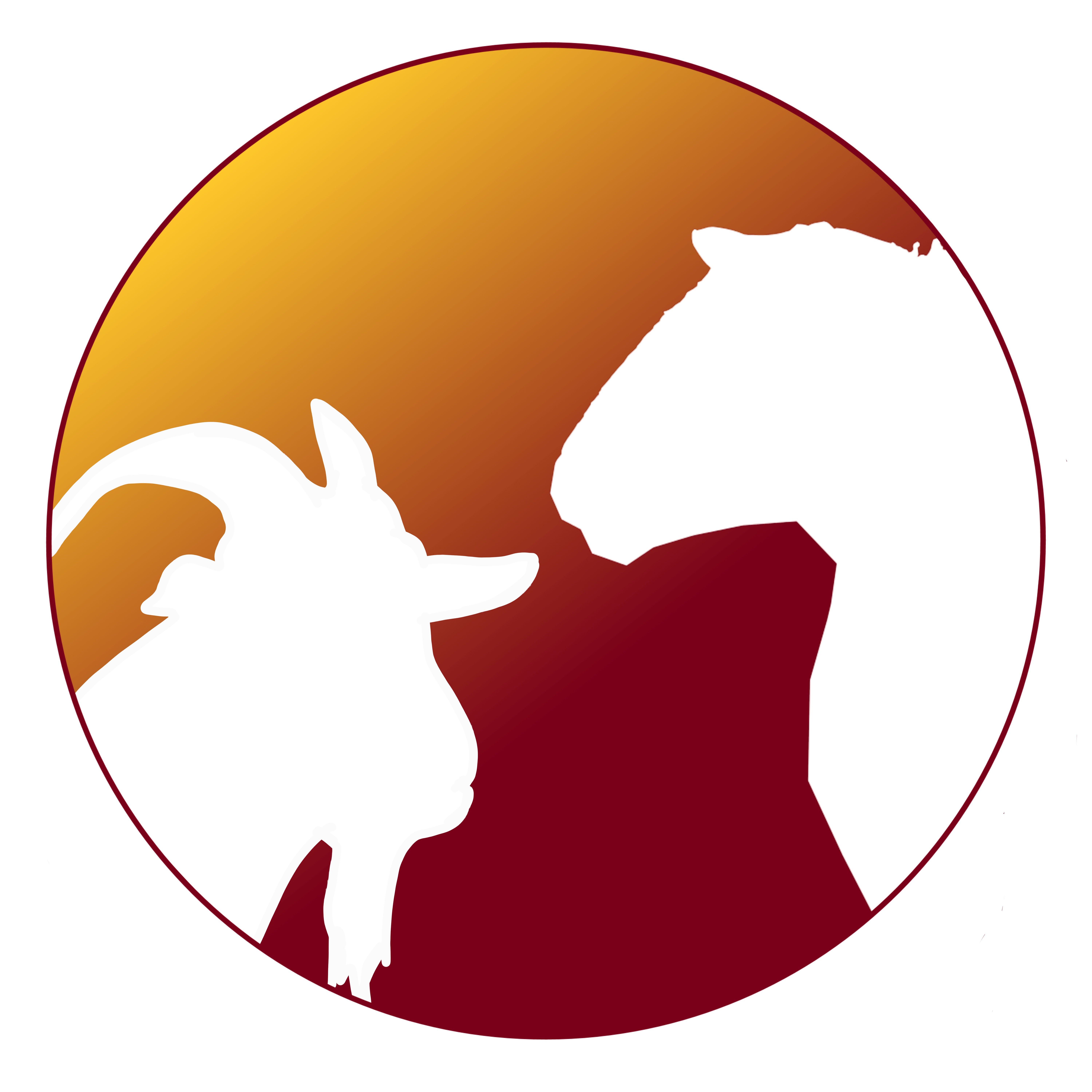 Feeding Sheep and Goats
Feeding Sheep and Goats
Sheep are bred in the fall and lamb in the spring after a 147 day gestation. Important times to consider changes in nutrition are one month prior to breeding, in the first month after bred, in the last month of gestation, and in the first 45 days of lactation. Lambs are weaned at 60-120 days of age and go to market at about 5 months of age.
The production cycle of goats is similar. The typical dairy goat is bred in the fall while still lactating from her previous pregnancy. Gestation is 150 days. She is dried off for the last 60 days of her pregnancy and kids in the spring. Lactation is 305 days.
The information below refers to goats but is applicable to sheep as well; the complete document from which this is drawn is in the External Resources folder for this section.
The greatest asset of goats is the ability and tendency to use woody plants and weeds not typically consumed by other species of animals (cattle and sheep), converting them into a saleable product. Therefore, these plant species can be inexpensive sources of nutrients and make for a very profitable goat enterprise. Goats typically consume a number of different plant species in any one day and can use some poisonous plants because they do not consume enough to be toxic. Similarly, goats are believed to have a relatively high ability to detoxify absorbed anti-nutritional factors. Goats are more resistant to bloating than other ruminants, and after a brief adaptation may graze alfalfa without bloating.
Body Condition Scoring
The adequacy of a nutritional program can be assessed by observing changes in body weight and condition of the animal. If animals lose weight, body condition will be reduced (animal is thinner), alerting an observant manager to a problem. Body condition is particularly responsive to energy and protein adequacy. Body condition scoring is a system of assigning a numerical score based on physical characteristics indicative of fatness. These include the amount of muscle and fat covering the spine in the loin area and ribs and fat pad at the sternum. Body condition scores range from 1 (very thin) to 5 (obese) in one-half score increments. Animals should achieve a certain body condition during specific periods of the production cycle. For example, animals should have a body condition of at least 2.5 but no more than 4.0 at the beginning of the breeding season. Prior to entering the winter a minimum score of 3.0 is desirable. Also, if body condition score is 4.5 or greater, pregnancy toxemia prior to kidding is likely, as also is the case with a score of 2.0 or less.
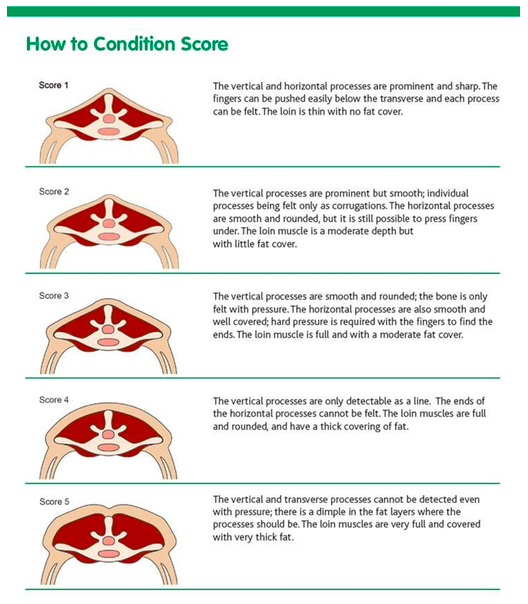
Nutrients must be provided using feedstuffs such as pasture, hay, concentrate, and minerals. For most goats throughout much of the year, nutrient requirements can be met by available pasture, a mineral supplement, and water. During times of limited forage availability or quality such as winter, or feeding poor quality hay or stockpiled forage, a supplement will be needed to supply deficient nutrients. The level of supplemental feeding should be adjusted with changes in animal requirements, such as increased needs of late pregnancy. Sometimes it may be preferable to put an animal in a lot and feed a complete diet or one high in concentrate such as with dairy goats.
There may be periods when nutrient requirements cannot be met, resulting in loss of body weight. This is acceptable at certain times in the production cycle if body condition is sufficient for the animal to draw upon body reserves and maintain the desired production level. An example would be weight loss during early lactation because sufficient nutrients cannot be consumed. However if the doe is in poor body condition, is a growing yearling, or has severe weight loss during this time, milk production will be depressed. During a drought, it may be acceptable for open or early pregnant animals that are not lactating to lose weight. During late pregnancy, inadequate nutrition can have adverse effects on pregnancy outcome and subsequent lactation. Severe undernutrition can cause abortion, reduced livability of the kid(s), and reduced milk production, and can adversely affect maternal behavior.
Feeding Different Classes of Goats
Feeding Bucks
Mature bucks can obtain most of their nutrients from pasture. However, yearling and 2 year old bucks have greater nutrient requirements since they are still growing. Bucks need to be in good body condition (BCS greater than 3) before the breeding season because feed intake may be relatively low during that time, with loss of body weight. Thus, body condition should be evaluated 3 months before the breeding season. Decisions can then be made on the supplemental nutrition needed for the buck to achieve the desired BCS. Whenever bucks cannot meet nutritional needs from pasture, supplementation is necessary. Under most conditions, whole shelled corn or sweet feed at 0.25 to 0.5% of body weight will be adequate (0.5 to 1 lb of feed for a 200 lb buck). Feeding bucks high levels of grain (greater than 1.5% of body weight) for a long period of time makes them prone to urinary calculi. The levels of grain recommended above are safe for bucks. When pasture is scarce, bucks can be fed medium quality hay free-choice.
Feeding Does Throughout their Life Cycle
The four production periods of does are dry nonpregnant, pregnant, late gestation, and lactating. Does that are open (nonpregnant) or in the early stage of pregnancy (< 95 days) have fairly low nutrient requirements. For open does, the goal is to gain a little weight to be in good condition for breeding. A medium quality pasture, such as in late summer, or a medium quality hay is sufficient to prepare for breeding and the early stage of pregnancy. However, adequate quantities of feed are necessary. Flushing refers to the practice of providing extra nutrition to does approximately 2 weeks prior to breeding and for a variable portion of the breeding period (e.g., 1-2 weeks) to increase the number of ovulations and have a greater proportion of twins and triplets. This is widely advocated with sheep producers and Angora goat producers. Producers have extrapolated the practice to meat goats. However, several controlled studies with Spanish goats in reasonable body condition (BCS 2.5 – 3.5) have shown no response in kidding or conception rate of meat goats to flushing with extra protein, energy, or both. The practice may have utility for meat goats in poor body condition, but there does not appear to be justification for flushing does in acceptable body condition.
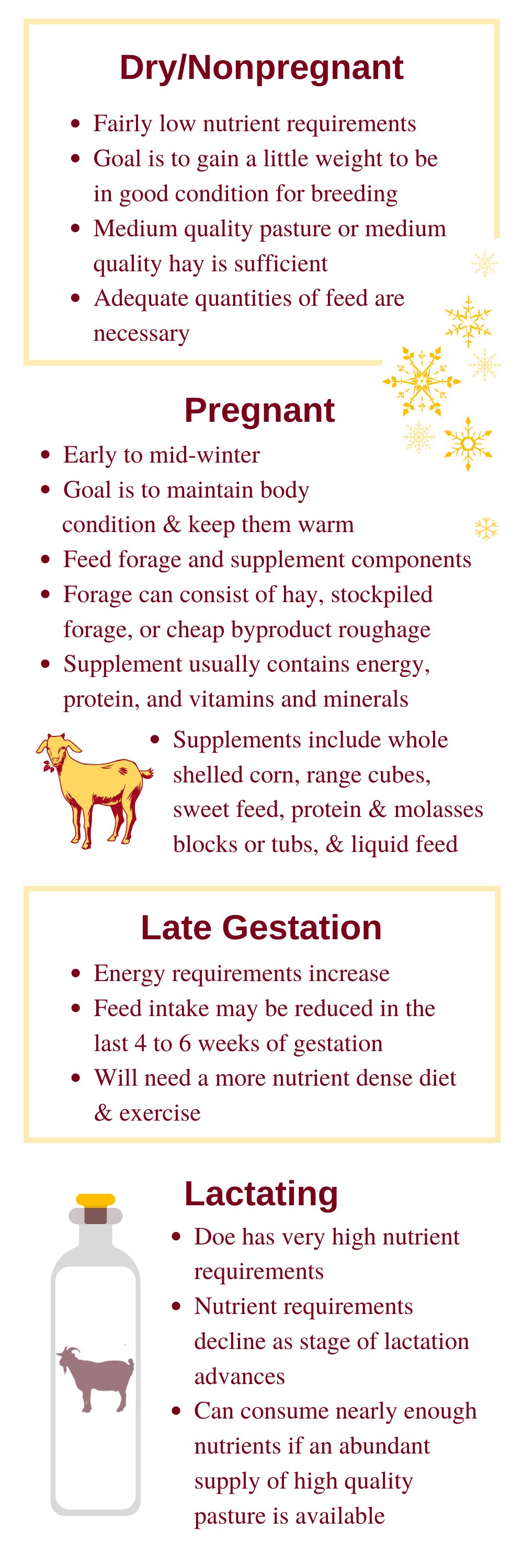
Winter Feeding of Does
Early to mid-winter is a time when does should be in early pregnancy. The goal of a wintering program is to economically provide the necessary nutrients to maintain a reasonable body condition, lose no weight, and keep them warm. In general, most wintering programs consist of both forage and supplement components. The forage component can consist of hay, stockpiled forage, or a cheap byproduct roughage feed. The supplement usually contains energy, protein, and often vitamins and minerals, although these may be provided separately as a mineral mix. Commonly used supplements include whole shelled corn (inexpensive source of energy), range cubes (inexpensive source of energy and protein), sweet feed, protein blocks, molasses blocks or tubs, and liquid feed. Stockpiled forage is forage that is grown during the summer or fall upon which animals are not allowed to graze, reserving it for the winter months. In drier areas, the forage is well preserved, but in a more humid climate quality declines rapidly, making the practice less satisfactory. Stockpiled forage is a very inexpensive forage source since it does not have to be mechanically harvested (baling forage doubles the cost of forage). Animals harvest stockpiled forage by grazing, which also decreases cost. Animals make much more efficient use of stockpiled forage when strip grazed (using temporary electric fence to limit animal access to an area containing a 1 to 3 day supply of forage) to minimize trampling. Fescue is used in many temperate regions for stockpiling and retains its quality well into late winter even in humid areas. Most recommendations for stockpiling fescue include late summer fertilization, clipping, and deferred grazing. Warm season grasses such as native range and Bermuda grass can be stockpiled. The amount of deterioration is dependent on grass species and rain.
Feeding Does in Late Gestation
Energy requirements increase dramatically in late pregnancy. Doelings require more supplementation than mature does, as the doelings are still growing. Feed intake may be reduced in the last 4 to 6 weeks of gestation by the growing kids that reduce available abdominal space. Pregnancy toxemia is a metabolic disease usually caused by animals being too fat (body condition score greater than 4) prior to kidding, although very thin animals (body condition score less than 2) are subject to the disease also. It is caused by a high demand for nutrients by the growing fetus in late pregnancy that is not being met (excess fat in the body and the growing fetus limit room in the stomach for food, reducing intake of the diet). This unmet nutrient demand causes a rapid breakdown of fat reserves, forming ketone bodies at high levels which are toxic. Treatments include administration of propylene glycol, large doses of B vitamins, glucose given intravenously, and possibly C-section. Prevention of the disease is far easier and more effective than treatment. Simply monitor animal body condition and adjust nutrition, especially energy, to manipulate body condition. Do NOT sharply reduce feed in late gestation as this may cause pregnancy toxemia. Also, pregnant goats in the last third of pregnancy will need a more nutrient dense diet (higher quality) due to fetal growth and reduced intake because of reduced stomach capacity. Exercise will help. Does can be encouraged to exercise by separating hay, feed and water at a substantial distance, forcing them to walk more.
Feeding the Lactating Doe
The lactating doe has very high nutrient requirements. During lactation, the doe can consume nearly enough nutrients if an abundant supply of high quality pasture is available, such as in spring or early summer. However, does will likely lose some bodyweight due to the high demands of peak lactation (weeks 3 to 8 of lactation) and an inability to consume an adequate quantity of feed. Kidding should take place when there is an adequate supply of high quality pasture. If there is not adequate pasture, supplemental feed will be required. Inadequate nutrition will decrease body condition, reduce milk production, reduce kid weaning weight, and increase kid mortality. When feeding high levels of grain, the animal should go through an adjustment period of two to three weeks during which time the grain portion of the diet is gradually increased to prevent digestion and other problems from occurring. Feeding a dairy ration and hay to a doe during late gestation and the lactating period will cost approximately $30 per animal. Utilizing available pasture as a feed source is a much cheaper alternative. Kids are usually weaned at about 12 weeks of age. Milk production of the doe begins to decrease after the 6th week of lactation and is quite low by the 12th week. Nutrient requirements decline as stage of lactation advances, enabling the doe to maintain body condition or even increase it on pasture alone. Kids may be creep fed while nursing to increase growth rate of the kids and reduce nutrient demands on the doe for milk production.
Creep Feeding
Creep feeding is a method of providing feed for the kids only. This is accomplished by fencing around a feeder and using a creep gate that has holes about 5 inch wide by 1 ft high. These holes are small enough so that kids can enter the feeder, but adults are excluded because they are too big to go through the hole. Creep feeding will provide extra growth for the kids and train them to eat feed, facilitating weaning. A commercial creep feed with at least 16% crude protein that is medicated with a coccidiostat should be used. It requires about 6 lbs of feed to produce 1 lb of animal gain. The more rapid growth from creep feeding may be beneficial for producing show prospects. An alternative to grain-based creep feeds that is used in the beef cattle industry is to creep graze calves, using a creep gate that allows calves access to ungrazed high quality pasture. This may have application for goats using high quality pastures (crabgrass or sudangrass that is planted for the kids). In rotational grazing of cattle, the calves are often allowed to creep graze the next pasture before cows so that they have relatively high nutrient intake. Those pastures often have less parasites and disease organisms because of the time since last grazing.

Effect of Kidding Season on Nutrient Requirements
Nutrient requirements of does change dramatically with stage of production. Requirements increase dramatically the last 6 weeks of gestation due to increasing fetal growth and remain high in early lactation. During the month prior to kidding and for the following 3 months (assuming weaning at 12 weeks of age), the doe will consume nearly as much nutrients as in the remaining 8 months of the production cycle. Thus, during that time it makes sense to supply nutrients from an inexpensive source, typically pasture. The cost of providing the same nutrients as hay is more than twice that of pasture, and supplying through purchased feeds may be four to five times greater than for pasture. Kidding should be planned for a time when pasture is rapidly growing. This period corresponds to late spring for pastures comprised of warm season forages such as Bermuda grass or native range, browse, and forbs, but could be either fall or early spring for cool season grasses such as ryegrass, wheat, orchard grass, and fescue. Cool season grasses usually produce less forage per acre than warm season forages, but generally are higher in energy and protein. Rapidly growing pasture is high in protein and energy. A major consideration in determining the date to kid is level of forage production at that time. However, there are other considerations in selecting kidding date, such as parasites and market opportunities. Some markets provide a substantial price premium from kidding at a specific time of the year, such as producing prospect show wethers or registered animals. However, it may take a considerable market premium to cover the cost of purchased feed, so general reliance on pastures and forages is best.
Artificial Raising of Kids
Sometimes it is necessary to bottle feed young kids due to death of the mother or the mother refusing to take them. It may be avoided by crossfostering kids onto another doe. If a bottle-raised kid is with other kids and does, they may learn to ‘steal’ sufficient milk to raise themselves. Kids can be raised on cow milk replacer, goat milk replacer (expensive) or, if none is available, cow milk from the store may be used. It is very important that kids receive colostrum within 12 hours of birth. After 12 hours, antibodies absorption decreases. Colostrum may be milked from another doe that recently kidded. Colostrum contains antibodies that strengthen the immune system for the first months of life. A kid should be fed one ounce of colostrum per lb of weight (average birthweight 7 lbs, therefore, 7 ounces of colostrum) at each of three feedings in the first 24 hours. If the kid is too weak to nurse, it is appropriate to provide the colostrum via stomach tube. This does take some practice, but obtaining colostrum is critically important to kid survival. Initially kids can be fed using a baby bottle or a nipple such as the Pritchard teat which fits on a plastic soda bottle. Kids can be bottle fed twice a day, although three times a day the first 4 to 6 weeks of life may increase growth rate. Kids are very susceptible to bloating and other gastrointestinal problems from milk replacers that contain a high level of lactose due to use of dried whey in their formulation. Reduced lactose milk replacers will reduce bloating problems. A calf starter feed (with a coccidiostat such as Rumensin or Deccox, sometimes called medicated) and high quality hay should be made available the second week of life. Deccox can be used in the milk from week 2-6 to prevent coccidiosis. After 4 weeks of life, kids can be limit fed milk at one pint in the morning and also in the afternoon. This will stimulate consumption of starter feed and facilitate weaning. Kids can be weaned after 8 weeks of age if they are consuming 2 ounces of starter per day and weigh two and a half times their birth weight (about 18 lbs). Weaning shock can be reduced by going to once daily milk feeding for several days to encourage consumption of the starter.
Note: Remember that any time you’re talking about medicated feed, under new legislation, a Veterinary Feed Directive is required – see the Drug Management chapter to learn more about veterinary feed directives.
Considerations in Ration Formulation
Rations should be balanced not only for protein and energy, but calcium and phosphorus contents should be calculated, macrominerals supplemented, and a trace mineralized salt used to provide microminerals. A vitamin premix should be used to provide at least vitamin A and E. If the diet is being fed at high levels to bucks or wethers, there is risk of urinary calculi. To prevent urinary calculi, the ration should be formulated with a minimum of phosphorus, over twice as much calcium as phosphorus, and a urine acidifier such as ammonium chloride at 0.5-1.0% of the diet. Salt can also be included in the diet, such as at 1%, to reduce incidence of urinary calculi. If the ration is being fed at high levels, sufficient fiber should be included in the diet to prevent acidosis. Dried brewers yeast and probiotics are often used in rations fed to animals at high levels to help prevent them from going off feed. Feeds may have a coccidiostat included in the formulation to prevent coccidiosis. There are a number of coccidiostats, but Food and Drug Administration approved drugs commonly used include Deccox and Rumensin. Since goats are very susceptible to coccidiosis when stressed, such as at weaning or shipping, many starters and show feeds contain coccidiostats and have the term ‘medicated’ on the feed tag. Management considerations to reduce coccidiosis incidence include sanitation, cleanliness, and dry housing.
Feeding Systems
There are many methods of feeding goats. Feeds should be offered in such a way to minimize mold growth or fecal contamination that reduces intake. Mineral mixes must remain dry and should be replenished at 2 week intervals to avoid caking. Feed troughs should be designed to facilitate removal of feces and leftover feed. Troughs generally require a bar running above the length of the trough to keep goats from defecating in them. Self feeders can be used for feeds containing sufficient roughage for use as a complete feed or for feed that has a built-in intake limiter. For large range operations, feeds such as whole shelled corn or range pellets or cubes are often fed on the ground. The feeding area is moved each day to have clean ground upon which to feed. Round hay bales should be fed in a rack off the ground. Feeding round hay bales on the ground results in hay wastage and leaves a mess that is difficult to clean. Hay can be fed in a manger or hay feeder with keyhole slots, but horns may cause problems preventing access to feed. For large operations, unrolling round bales on the ground works well.
*
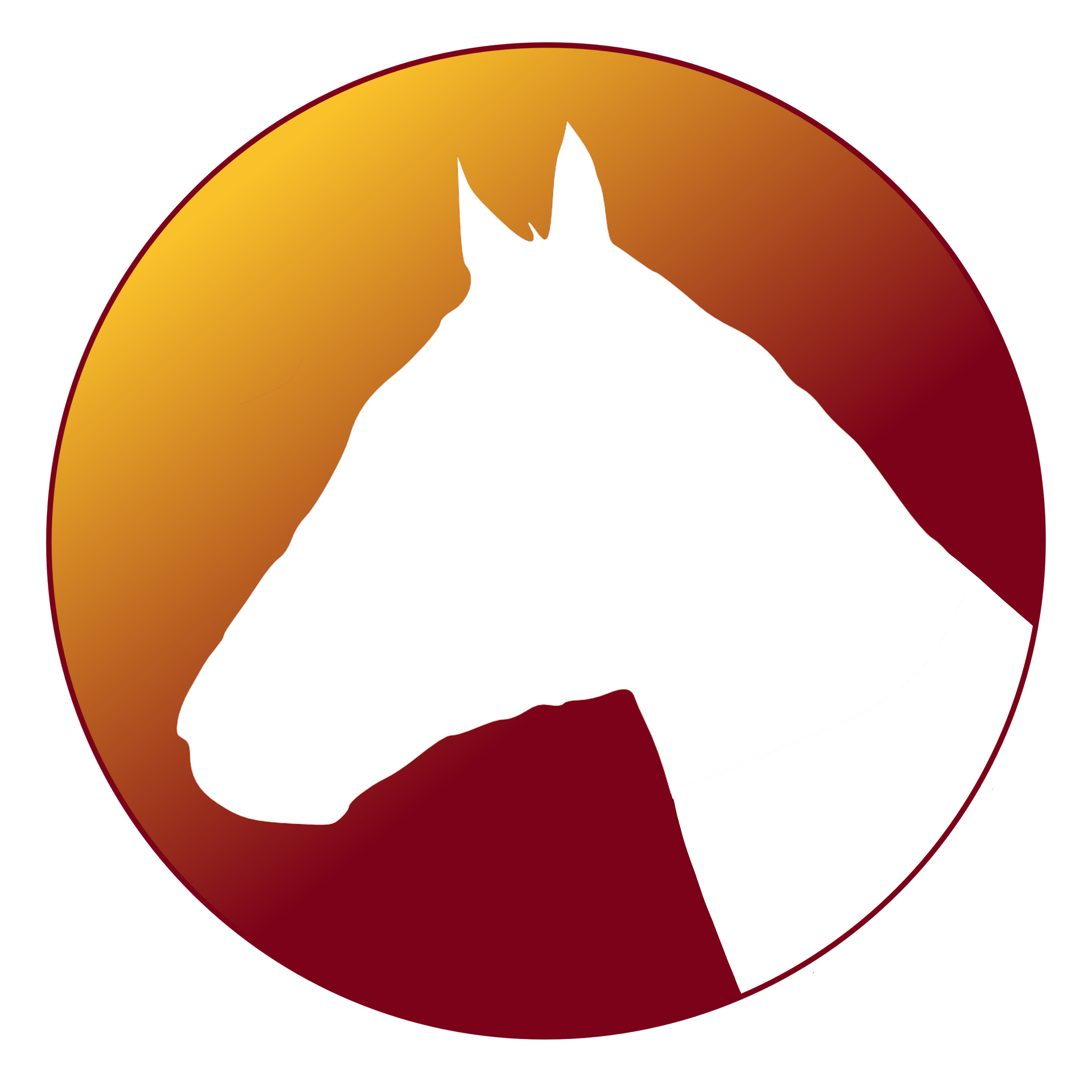 Feeding Horses
Feeding Horses
Horses are social animals with an established hierarchy. Wild horses are nomadic, following the food, and don’t defend a set territory. They are herbivores with a forage-based diet. They are grazers or trickle feeders, designed to eat numerous small meals throughout the day. They tend to feed more heavily at dawn and dusk.
Horse Anatomy
Horses have hypsodont teeth that erupt over the life of the horse. Horses prehend with their tongue and incisors, moving the bolus to the back of the mouth where it is ground by the cheek teeth (premolars and molars). Side-to-side chewing motion maximizes grinding. Differences in tooth wear are noted between forage and concentrate-based diets. Intense mastication by the cheek teeth leads to reduction in particle size and stimulates production of saliva, which is 99% water and serves primarily as a lubricant. There are virtually no digestive enzymes in equine saliva but it does provide buffering of gastric contents. Saliva secretion increases with increased dry matter (DM) intake (i.e. forage requires more chewing than concentrates and is associated with larger volume of saliva). Careful chewers will reduce particle size of ingested feeds to 1-2 mm, which allows for more complete exposure of feeds to enzymatic digestion in the small intestine.
The esophagus is 1.2-1.5 meters (4-5 ft) long from the pharynx to the cardia of the stomach with upper and lower esophageal sphincters. It is lined with stratified squamous epithelium and has no secretory function. The sequence of motility follows – food enters pharynx, upper esophageal sphincter relaxes, peristalsis, distal movement of bolus, lower esophageal sphincter relaxes, bolus enters stomach – total transit time is 4-10 seconds.
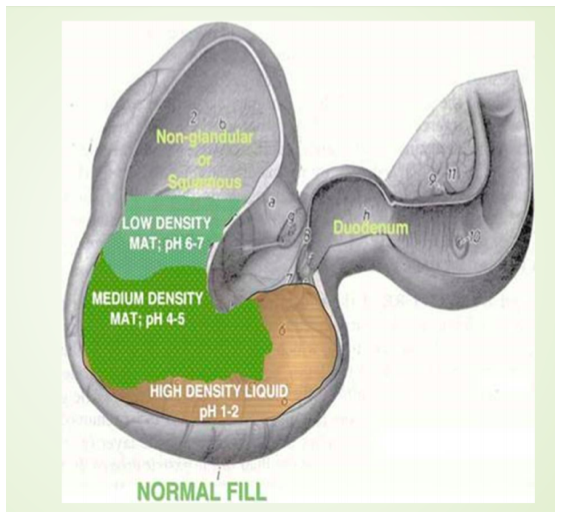
Stomach volume is 8-15 L (about 8% of the total GI tract). The proximal half is non-glandular, and the distal half is glandular. The fundic mucosa produces HCl (continuous, highly influenced by type of feed), and the pyloric mucosa produces gastrin. The gastric bacterial population contributes to digestion of non-structural carbohydrates – this population is pH dependent and produces lactic acid and VFAs. Gastric emptying time for water is 30-90 minutes, for high-fiber / low-starch diets about 90 minutes, and for low-fiber / high-starch diets 2-4 hours; meal size also affects rate of gastric emptying. Little absorption of nutrients occurs here.
The small intestine is 25 meters (82 ft) long – passage of foodstuffs occurs at a rate of 6-90 cm/min. This is the major site of enzymatic digestion and absorption of nutrients such as glucose, amino acids, fatty acids, fat-soluble vitamins, calcium, phosphorus, magnesium, and water. The small intestine is the only site of calcium absorption in the equine GI tract.
The hindgut is made up of the cecum, large (ascending) colon, small colon, and the rectum. This is the major site of microbial fermentation and fluid absorption – horses are hindgut fermenters. The hindgut processes plant components that do not get broken down in the small intestine. A huge resident microbial population is responsible for digestion of fibrous matter and includes bacteria, fungi, and protozoa. VFAs, fructans (complex sugars), nitrogen, sodium, chloride, and water are absorbed. Simple sugars (glucose, fructose), amino acids, fatty acids, and fat soluble vitamins are not absorbed in the hindgut. The small colon is responsible for desiccation and formation of fecal balls.
Nutrient Requirements of Horses
- Water – Requirement is 30-60 ml/kg/day in adults (4-8 gallons or 15-30 L). Requirements fluctuate with ambient temperature, exercise, pregnancy, lactation, etc. Water may be consumed with diet when on pasture (40-60% water). A goal is to maximize water consumption. Horses can be very finicky about temperature of water, bucket, location, etc.
- Energy – Horses eat to meet their energy needs. Need is heavily influenced by life stage, body condition, and ambient temperature. The most useful term for practical purposes is digestible energy (DE) = gross energy minus energy lost in feces – Maintenance DE (Mcal/day) = 1.4 + (0.03 x BW in kg) for horses 600 kg or less (1 Mcal = 1000 kcal).
- Carbohydrates – The principle source of energy in equine diets and come from forages and grains. Some are hydrolyzed to simple sugars in the small intestine, leading to absorption of glucose into the bloodstream, and some undergo bacterial fermentation in the hindgut. More energy is derived from those broken down in the small intestine than from those metabolized in the hindgut. There are no established maximum or minimum requirements for carbohydrates.
- Protein – A source of energy and is the major component of most tissues in the body. It is obtained from feed and is digested and absorbed primarily in the small intestine. Quality of the protein affects its digestibility and therefore the amount that must be fed. Digestion of protein is initiated in the stomach through the actions of HCl and pepsinogen and is completed in the small intestine. Undigested protein is absorbed as nitrogen in the cecum. Essential (also called indispensable) amino acids cannot be synthesized and must be obtained in the diet. Dispensable amino acids can be synthesized. For conditionally indispensable amino acids, pathways exist but at times the body cannot make them in sufficient quantities. The essential amino acids in horses are lysine, methionine, threonine, isoleucine, leucine, valine, phenylalanine, tryptophan, histidine, arginine – Lysine is the first limiting amino acid in equine diets (first one to be used up and therefore prevent further protein synthesis), followed by threonine and methionine.
- Lipids – A source of energy absorbed in the small intestine as fatty acids; fats are highly digestible and are required for absorption of fat-soluble vitamins (A, D, E, K). Essential fatty acids (FAs) must be supplied in the diet and include linoleic (0.5% of DM) and alpha-linoleic acids. Omega FAs – omega 6 = linoleic, gamma-linoleic and arachidonic acids – these are potent inflammatory mediators from soy, corn, sunflower, and safflower oils. Omega 3 = alpha-linoleic, eicosapentaenoic acid (EPA), and docosahexaenoic acid (DHA) – these are less potent inflammatory mediators from flaxseed oil or fish oil. Forage diets (fresh forage and hay) are naturally higher in omega 3 FAs. Cereal grains, soybean meal, rice bran, and vegetable oils are higher in omega 6 FAs. Dietary recommendations for horses are still under investigation. Supplementation is aimed at inflammation and immune function – flaxseed and fish oil often are used. Benefits of fat supplementation are increased energy density for weight gain and replacing carbohydrates as sources of calories. Palatability is the major factor in how much fat you can supplement. Fats must be added gradually to the diet. Oxidation also is an issue. Vitamin E supplementation is suggested when adding fat to the diet.
- Vitamins and Minerals – Vitamin requirements are set based on daily DM intake. For fat-soluble vitamins, toxicities are rare and deficiencies are more common. There are high concentrations in fresh forage. In dried forage (hay), vitamin A, D, and E levels decrease rapidly. Supplementation is recommended for horses not on pasture. Water-soluble (“natural”) vitamin E is more bioavailable than are synthetic forms. Water-soluble vitamins are thiamin and riboflavin. Macrominerals that are required in the diet include calcium, phosphorus, sodium, chloride, magnesium, and potassium. Calcium absorption is estimated at 50% and is variable depending on the source. Vitamin D plays a smaller role in Ca:P homeostasis in horses than in other species. Phosphorus absorption varies widely, averaging 33%. Ca:P ratio more important than absolute numbers; ideal is a ratio of 1.5:1 to 2:1. High calcium can negatively impact phosphorus absorption and vice versa. Microminerals that are required in the diet include copper, zinc, iron, selenium, manganese, cobalt, and iodine. Dietary toxicity can be seen if microminerals are fed in excess. Selenium should be a maximum of 0.5 mg/kg DM intake. Selenium deficient soils exist in different parts of the United States, so having an understanding of local growing conditions (and/or a hay analysis) is key to making good decisions about supplementation. The maximum tolerable concentration is 2 mg/kg DM; selenium toxicity is a clinical concern.
Types of Horse Feed
Forage
The stems, leaves and stalks of plants – pasture = fresh forage, hay = dried forage. Horses should consume at least 70% of their diets (ideally 80-100%) in forage. No forage is 100% complete so some vitamins/mineral supplementation will be required. Minimum requirement = 1% of BW in forage daily (ideally 1.5-2%). Type of forage available varies with region and time of year. Cool season grasses = orchard grass, Kentucky bluegrass, timothy, ryegrass, bromegrass, tall fescue. Warm season grasses = Bermuda grass, teff. Legumes = alfalfa and clover.
Concentrates
Cereal grains such as corn, oats, barley, wheat, rye, and millet. These are highly digestible with a high concentration of soluble carbohydrates. They are usually processed by cracking, grinding, steaming, and flaking. Many have an inverted Ca:P ratio. Grain should be limited to less than 30% of the overall diet. Concentrates can be used to supplement calories, vitamins, and minerals lacking in forage.
Supplemental Feeds
These may be added to forage. These may be pelleted, and may be cereal grains, and supplemental protein or vitamins/minerals, for example Purina Ultium. Ration balancers are very concentrated sources of vitamins and minerals designed to be fed with either grass forage or alfalfa forage, for example Nutrena Empower Grass Balancer. Complete feeds are designed to be fed as the sole source of nutrition in the absence of forage. These are forage-based and often are pelleted and softened by the addition of water, for example, Purina Equine Senior.

By-Product Feeds
These are as in other species and include beet pulp, wheat bran, and rice bran.
Macronutrient Supplements
Protein may be added to improve quality of forage and to aid in building muscle, hair and hooves. Owners can use as a protein supplement, a complete feed, or alfalfa (forage or pellets). Don’t use human supplements; equine-specific supplements often are soy or whey-based. Other examples are soybean meal, fish meal, meat and bone meal, cottonseed, and linseed. Fats may be plant or animal based. Examples are rice bran, fish oils, and flax. Fat supplements have variable palatability and digestibility. Essential fatty acids vary between oils – omega 3 flax>soy> canola>sunflower> corn. Flax oil has an omega 3:omega 6 ratio of 4.2. Corn oil has an omega 3:omega 6 ratio of 0.2. Feed supplemental vitamin E when feeding > ½ c oil/day (1000-2000 IU vitamin E/cup of oil). Limit flax to ½ cup oil or 1 pound of flaxseed per day.
Salt and Trace Minerals
Salt should be provided free choice. Salt blocks may contain iodine. Loose salt may be added to the bucket to encourage water consumption (1-3 tsp BID). Trace mineral blocks are okay if only one horse has access but it is hard to guarantee adequate consumption. Trace mineral blocks are not necessary if the diet is complete. Many vitamin and mineral mixes are available and again are not necessary if the diet is complete.

Ideal Feeding Practices
Feed horses like horses – Horses are designed to eat for up to 18 hours per day. Their cycle is eat – drink – sleep – repeat. Horses selectively graze areas where they have not defecated and remove the tops of plants that are actively growing. Continuous grazing maximizes saliva production, and decreases risk of gastric ulcers, colic, and vices. Horses on 24 hour turn-out will consume about 2 to 2.5% of their body weight /day in dry matter. If pasture is limited, they will actually consume more per hour. It is ideal to:
- Monitor the horse’s body weight
- When estimating, consistency is key. Have the same person do the measurements each time, use consistent landmarks, and take digital photos.
- Monitor the horse’s Body Condition Scoring (BCS)
- Monitor as in other species. A BCS of 5 on 9-point scale is ideal. Evaluate the horse from all angles and do a hands-on evaluation as well. Key areas to evaluate are the neck, shoulder, barrel (ribs), and tailhead. A horse with BCS less than 4 needs more calories and a horse with BCS greater than 6 needs fewer calories.
Humans may mess up horses’ body weight and condition by:
- Limiting access to feed – Horses will eat 2-3% of their body weight daily. Forage must be available. 80-100% of their diet should be forage. Horses should go no more than 2-3 hours without forage intake. Forage can be fresh or dried.
- Overfeeding – Not all horses will self-regulate, especially when turnout is restricted. Compensating for decreased turnout with free choice hay may work but must be monitored.
- Overfeeding concentrates, supplements, treats – Cereal grains are very high in non-structural carbohydrates, are not tolerated by all horses, and are not needed by all horses, leading to disease (obesity, equine metabolic syndrome, and laminitis).
- Underfeeding supplemental feeds – Feeding a concentrate at less than label recommendations can lead to nutrient deficiencies. If forage is fed solely in the form of hay, vitamins A and E will need to be supplemented.
Consequences of poor feeding practices include obesity, poor performance, starvation, insulin resistance, colic, gastric ulcers, and laminitis.

*
 Extra Resources
Extra Resources
- Monitoring the horse’s body weight: https://www.youtube.com/watch?v=IVVQcTgynDc
- Monitoring the horse’s body condition scoring (BCS): https://ker.com/wp-content/uploads/body-condition-score-chart.pdf
- Goat nutrition: https://pressbooks.umn.edu/app/uploads/sites/7/2019/08/Goat-nutrition-for-health.pdf

